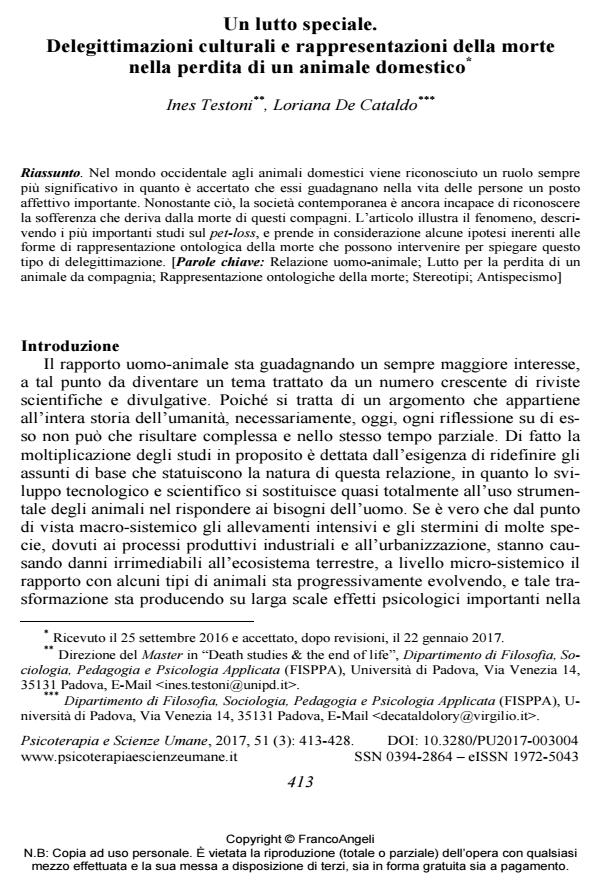Un lutto speciale. Delegittimazioni culturali e rappresentazioni della morte nella perdita di un animale domestico
Titolo Rivista PSICOTERAPIA E SCIENZE UMANE
Autori/Curatori Ines Testoni, Loriana De Cataldo
Anno di pubblicazione 2017 Fascicolo 2017/3
Lingua Italiano Numero pagine 16 P. 413-428 Dimensione file 207 KB
DOI 10.3280/PU2017-003004
Il DOI è il codice a barre della proprietà intellettuale: per saperne di più
clicca qui
Qui sotto puoi vedere in anteprima la prima pagina di questo articolo.
Se questo articolo ti interessa, lo puoi acquistare (e scaricare in formato pdf) seguendo le facili indicazioni per acquistare il download credit. Acquista Download Credits per scaricare questo Articolo in formato PDF

FrancoAngeli è membro della Publishers International Linking Association, Inc (PILA)associazione indipendente e non profit per facilitare (attraverso i servizi tecnologici implementati da CrossRef.org) l’accesso degli studiosi ai contenuti digitali nelle pubblicazioni professionali e scientifiche
Nel mondo occidentale agli animali domestici viene riconosciuto un ruolo sempre più significativo in quanto è accertato che essi guadagnano nella vita delle persone un posto affettivo importante. Nonostante ciò, la società contemporanea è ancora incapace di riconoscere la sofferenza che deriva dalla morte di questi compagni. L’articolo illustra il fenomeno, descrivendo i più importanti studi sul pet-loss, e prende in considerazione alcune ipotesi inerenti alle forme di rappresentazione ontologica della morte che possono intervenire per spiegare questo tipo di delegittimazione.
Parole chiave:Relazione uomo-animale; Lutto per la perdita di un animale da compagnia; Rappresentazione ontologiche della morte; Stereotipi; Antispecismo
- Un'insolita interazione col mondo animale. Note in margine a una storia clinica Cesare Secchi, in INTERAZIONI 1/2022 pp.95
DOI: 10.3280/INT2022-001011 - Ecologies of care: qualitative insights from a psychosocial study on veterinarians’ experiences in Northeastern Italy Ciro De Vincenzo, Ines Testoni, in Frontiers in Veterinary Science 1650809/2025
DOI: 10.3389/fvets.2025.1650809 - Social Support in Perinatal Grief and Mothers’ Continuing Bonds: A Qualitative Study With Italian Mourners Ines Testoni, Jenni Bregoli, Sara Pompele, Andrea Maccarini, in Affilia /2020 pp.485
DOI: 10.1177/0886109920906784
Ines Testoni, Loriana De Cataldo, Un lutto speciale. Delegittimazioni culturali e rappresentazioni della morte nella perdita di un animale domestico in "PSICOTERAPIA E SCIENZE UMANE" 3/2017, pp 413-428, DOI: 10.3280/PU2017-003004